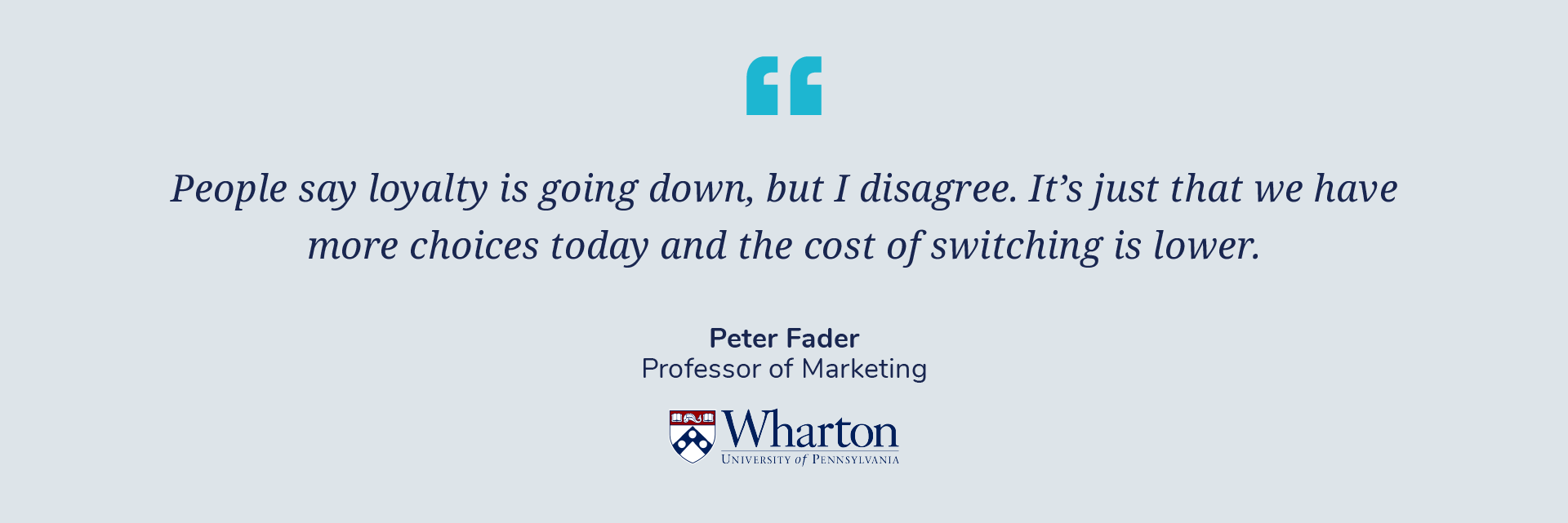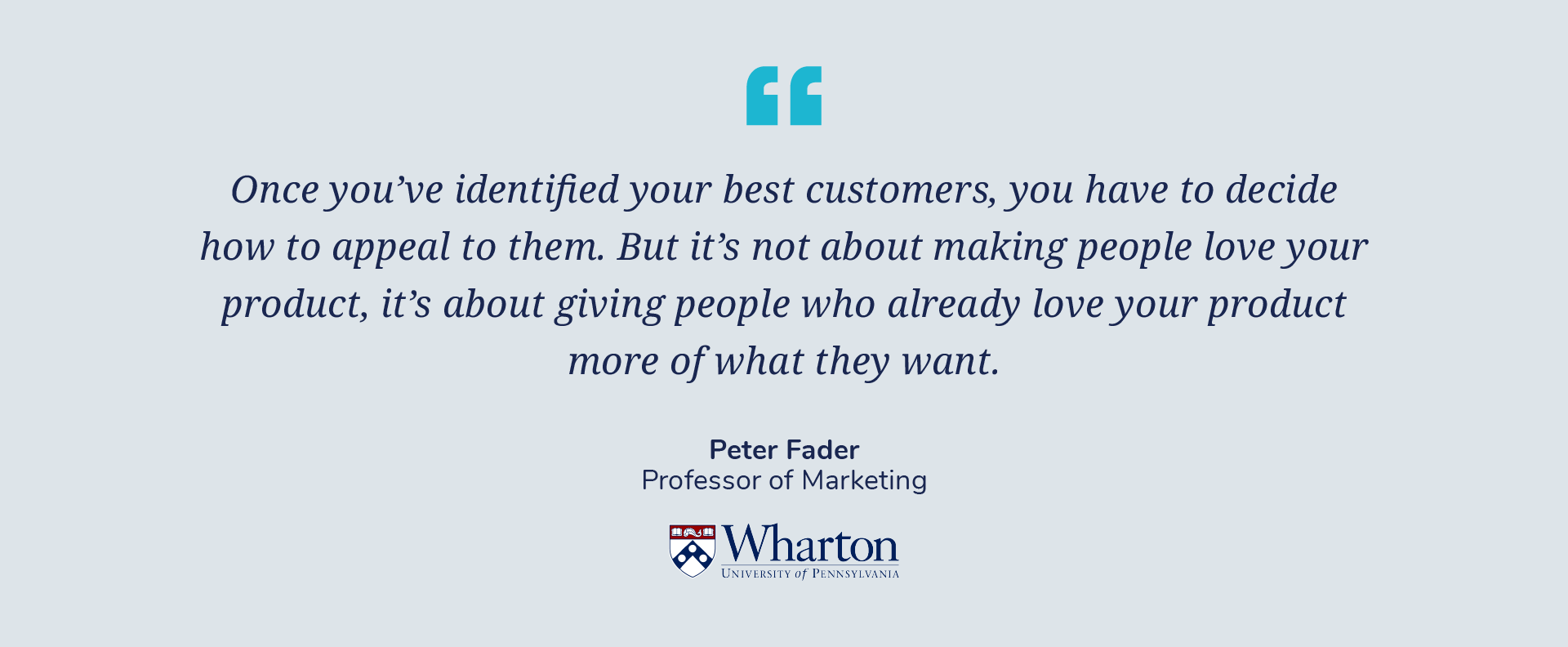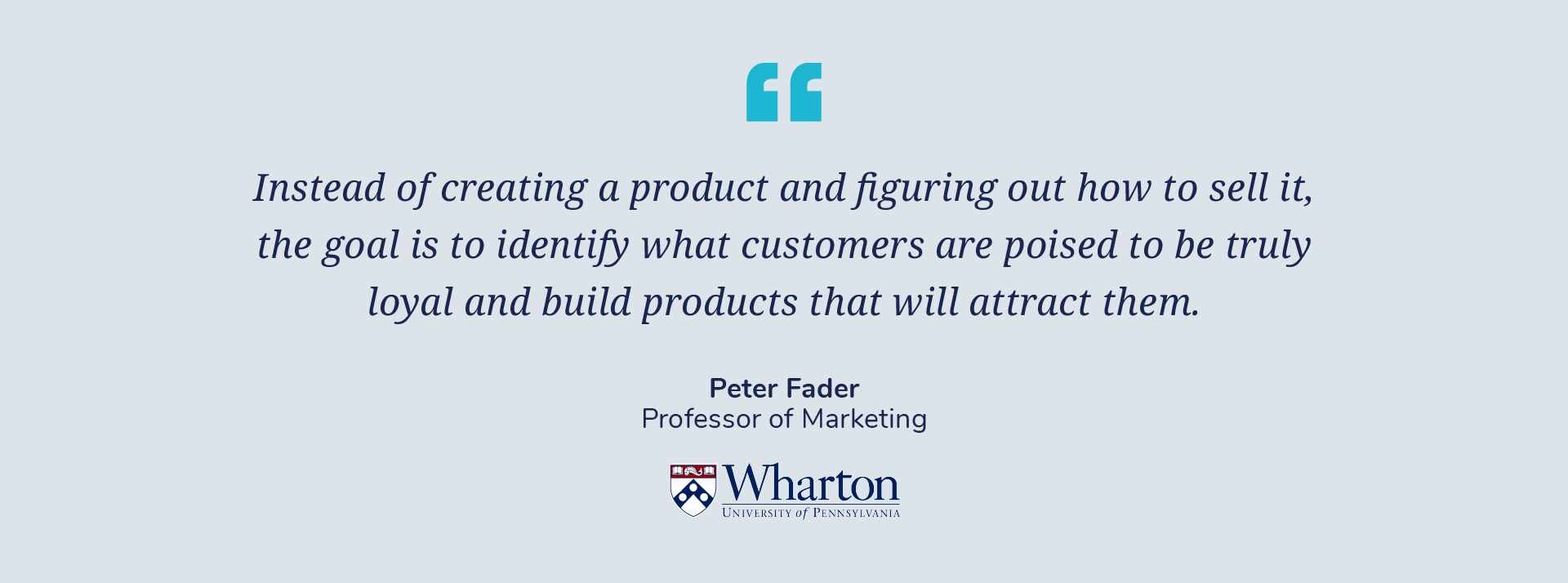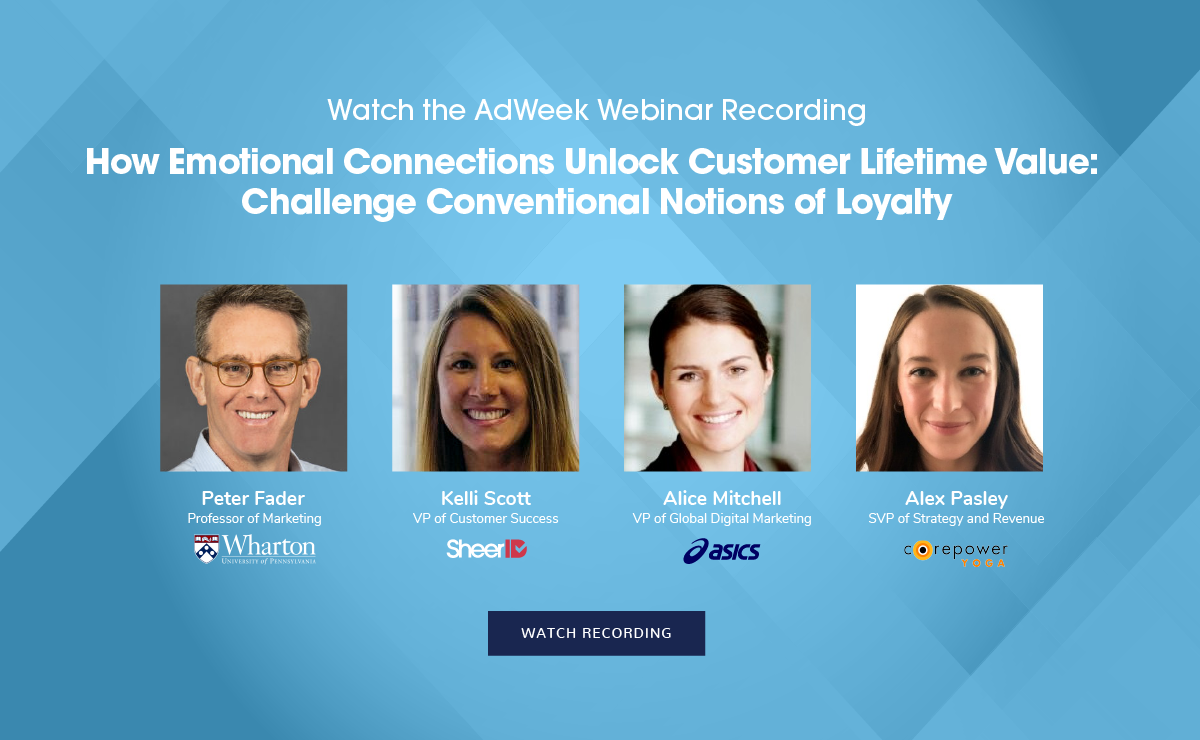The days of growing a business by acquiring new customers as cheaply as possible are over. True profitability will only come when you do the hard analysis to identify your best customers, serve them incredibly well, and ignore the rest. This is the path to maximize the value they bring to your company.
So says Peter Fader, the renowned professor of marketing at the Wharton School of the University of Pennsylvania, and his decades of research back it up.
I had the pleasure of speaking with Peter about his views on customer loyalty, why most marketers are doing it wrong, and what they can do to turn things around in today’s economy where customers have near limitless choices.
Below are highlights from my interview, but for even more insight into how you can grow enduring CLV, watch the Adweek webinar with Peter and executives from ASICS, CorePower Yoga, and SheerID.
Bill Schneider
Peter, thanks for spending time with me today. Building customer loyalty is getting a lot more attention of late as consumers carefully scrutinize discretionary spending. And it’s not a new term so there can be a lot of different definitions of what it means. How do you define customer loyalty?
Peter Fader
I like the definition in a book by my late Wharton colleague, Rich Oliver. Customer loyalty is the customer’s willingness and desire to stick with you despite having plenty of opportunities to leave.
We often define it like, “Hey, those customers are doing stuff with us over and over. They must be loyal.” But in many cases, that’s actually inertia. Customers might not care enough to switch, or they might believe switching would be too expensive. Or it might be psychological, like when you don’t necessarily like your dentist but it’s too much of a hassle to find a new one.
Bill Schneider
I like that definition because it clearly puts the customer in the center of the picture and focuses the attention on what they value that will encourage them to stick with a brand.
Peter Fader
That’s a great point. People say loyalty is going down, but I disagree. It’s just that we have more choices today and the cost of switching is lower. We’re operating in a different world.
Byron Sharp, a marketing science professor at the University of South Australia, says that when people make purchasing choices, it’s like rolling a die. It’s less about their “stickiness” with a brand and more about their tendency to simply lean towards it, but each decision (or die roll) is independent. That’s not nearly as compelling as traditional views of loyalty, but it’s supported very well by the data.
Brands will invest money in trying to get a consumer to develop a habit of choosing them, but I’m not much of a believer in habit. It’s more about heterogeneity, i.e., that different people have different dice. It’s an unconventional way of looking at things, but it leads to better decisions.

Bill Schneider
So the question isn’t “What will increase stickiness?” but rather “What increases the probability that a customer will choose our brand?”
Peter Fader
Exactly. And the answer is that it’s really hard. Brands want to turn your 10% chance of choosing them into a 60% chance. That’s extremely difficult to do, and the ROI on efforts to do that are very low. It’s like chasing after the Holy Grail.
You’re better off finding people who are inherently more inclined to choose your brand – who are rolling better dice. That requires doing more research and spending more money to find people who naturally align with your brand. It’s more difficult and expensive, and it goes against the grain of all traditional marketing, but it leads to a better ROI in the long run.
Bill Schneider
Why does that go against the grain?
Peter Fader
Companies want to feel like they have more control, that they can “manage” the customer relationship by educating, nurturing, and persuading customers. But it turns out that, at the margin, that stuff is really hard. We can’t necessarily change the nature of the die you’re rolling, but maybe we can get you to roll it more often.
We can influence category incidence, but it’s harder to influence brand choices. So we can remind you to buy athletic footwear more often and just hope the people who are rolling dice that favor our brand will roll more often.
Bill Schneider
What do you think about the idea of being there when the customer needs you?
Peter Fader
That’s a very good point. You can try to be ubiquitous. You can focus on being omnichannel and offering a variety of features, benefits, and capabilities. So instead of being the best at one thing, you’re pretty good at everything. Then when the need arises for something else – like shoes to wear to work or a party – you’re top of mind.
Bill Schneider
Your work also says that you can increase the probability that customers will choose your brand by identifying who your best customers are.
Peter Fader
Finding the right customers is what gives you the strategic advantage. Conventional marketing says to acquire as many customers as you can as cheaply as possible. But I’m saying spend more money. If you’re willing to invest more and be smarter about it, you’ll improve your odds of getting those customers with the right propensities. You may be less efficient, but you’ll be more effective.
Bill Schneider
What are some companies that are doing this right?
Peter Fader
Nike is a great example. They used to be a company that simply sold boxes of shoes to Walmart and Foot Locker without any visibility into who was actually buying them.
When they were a client of mine at Zodiac, my first company, we focused on analyzing who their customers were and how they were using Nike products. Once Nike understood that, they got much smarter about which kinds of stores to sell through. They’re one of the few companies that looked Amazon in the eye and said, “We’re not selling through you.” They found that Amazon just wasn’t bringing in very valuable customers.
Prioritizing the best customers is also something we also see a lot in gaming companies. They used to just develop games they thought would be wildly popular, but now many of them try to focus on appealing to the customers they know are really valuable.
Instead of creating a product and figuring out how to sell it, the goal is to identify which customers are poised to be truly loyal and build products that will attract them.
Bill Schneider
So, instead of focusing on how to sell more products, you ask which are my best customers and how can I serve them better?
Peter Fader
Exactly. And it takes a mindshift across the entire organization. Companies should manage their customer segments the same way they manage their products. Dig into the data to find out what your best customers want, and then create it for them.
We actually see this a lot with private wealth management. They identify which customers are whales and what financial instruments those customers are interested in. And that’s what they offer.
That’s the difference between a product-centric company and a customer-centric one. Some companies balk at that idea, and others say bring it on. The companies that embrace it will win.

Bill Schneider
There was a recent study by Forrester consulting that stated that inspiring the right emotions is the primary driver of customer loyalty. How does that factor into increasing the probability that customers will choose your brand?
Peter Fader
That’s a great question. Once you’ve identified your best customers, you have to decide how to appeal to them. But it’s not about making people love your product, it’s about giving people who already love your product more of what they want, so they feel valued by your brand.
Bill Schneider
How do you make customers feel valued and excited about what you’re providing to them?
Peter Fader
I love this question because it takes us right back to the beginning. You have to ask, why are those customers so valuable to us? If they’re staying with you because the cost of switching is too high, you have to give them reasons to like you, so they don’t feel like they’re your customers against their will.
For the customers who chose to stay, even if there’s no cost to switching, you don’t need to remind them of all the reasons they love you. Instead, you just bring them news they can use without being annoying about it. You understand how they’re using your product and you focus on enhancing that experience.
Most marketers will create messaging that connotes certain kinds of emotions and blanket their audience with it, but that might be unappealing to both groups of customers. It might even be going after some average customer that doesn’t even exist. So you aim different messages at different customers, but always informed by what the data tells you about them.
The work SheerID is doing to help brands provide exclusive offers to specific communities like teachers and the military is a great example of how a brand can send the message to its best customers that the brand values them and wants to keep them engaged.
Bill Schneider
Yes. We find that when a brand rewards those communities with a special offer, it leads to greater engagement and higher CLV.
Ok, we could keep talking for hours but we’re out of time. I look forward to continuing the conversation at the Adweek webinar.










